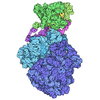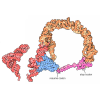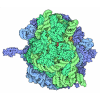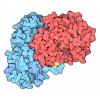+ Open data
Open data
- Basic information
Basic information
| Entry |  | |||||||||||||||
|---|---|---|---|---|---|---|---|---|---|---|---|---|---|---|---|---|
| Title | Damaged 70S ribosome with PrfH bound | |||||||||||||||
 Map data Map data | cryo-EM map of damage 70S E. coli Ribosome rescured by C. gingivalis PrfH | |||||||||||||||
 Sample Sample |
| |||||||||||||||
 Keywords Keywords | CgPrfH / damaged ribosome / ribotoxin / RIBOSOME | |||||||||||||||
| Function / homology |  Function and homology information Function and homology informationnegative regulation of cytoplasmic translational initiation / stringent response / transcriptional attenuation / endoribonuclease inhibitor activity / RNA-binding transcription regulator activity / translational termination / negative regulation of cytoplasmic translation / DnaA-L2 complex / translation repressor activity / negative regulation of translational initiation ...negative regulation of cytoplasmic translational initiation / stringent response / transcriptional attenuation / endoribonuclease inhibitor activity / RNA-binding transcription regulator activity / translational termination / negative regulation of cytoplasmic translation / DnaA-L2 complex / translation repressor activity / negative regulation of translational initiation / negative regulation of DNA-templated DNA replication initiation / mRNA regulatory element binding translation repressor activity / ribosome assembly / transcription antitermination / translational initiation / DNA-templated transcription termination / response to radiation / maintenance of translational fidelity / mRNA 5'-UTR binding / large ribosomal subunit / ribosome binding / transferase activity / ribosomal small subunit biogenesis / ribosomal small subunit assembly / small ribosomal subunit / 5S rRNA binding / small ribosomal subunit rRNA binding / ribosomal large subunit assembly / cytosolic small ribosomal subunit / large ribosomal subunit rRNA binding / cytosolic large ribosomal subunit / cytoplasmic translation / tRNA binding / negative regulation of translation / rRNA binding / structural constituent of ribosome / ribosome / translation / ribonucleoprotein complex / response to antibiotic / negative regulation of DNA-templated transcription / mRNA binding / DNA binding / RNA binding / zinc ion binding / membrane / cytosol / cytoplasm Similarity search - Function | |||||||||||||||
| Biological species |   Capnocytophaga gingivalis (bacteria) Capnocytophaga gingivalis (bacteria) | |||||||||||||||
| Method | single particle reconstruction / cryo EM / Resolution: 2.65 Å | |||||||||||||||
 Authors Authors | Tian Y / Li Q / Jin H / Fatma S / Zeng F / Huang RH | |||||||||||||||
| Funding support |  United States, United States,  China, 4 items China, 4 items
| |||||||||||||||
 Citation Citation |  Journal: bioRxiv / Year: 2025 Journal: bioRxiv / Year: 2025Title: Molecular and structural basis of a subfamily of PrfH rescuing both the damaged and intact ribosomes stalled in translation. Authors: Yannan Tian / Qingrong Li / Shirin Fatma / Junyi Jiang / Hong Jin / Fuxing Zeng / Raven H Huang /   Abstract: In bacteria, spontaneous mRNAs degradation and ribotoxin-induced RNA damage are two main biological events that lead to the stall of protein translation. The ubiquitous trans-translation system as ...In bacteria, spontaneous mRNAs degradation and ribotoxin-induced RNA damage are two main biological events that lead to the stall of protein translation. The ubiquitous trans-translation system as well as several alternative rescue factors (Arfs) are responsible for rescuing the stalled ribosomes caused by truncated mRNAs that lack the stop codons. To date, protein release factor homolog (PrfH) is the only factor known to rescue the stalled ribosome damaged by ribotoxins. Here we show that a subfamily of PrfH, exemplified by PrfH from (PrfH), rescues both types of stalled ribosomes described above. Our biochemical assays demonstrate that PrfH hydrolyzes the peptides attached to P-site tRNAs when in complex with both the damaged and intact ribosomes. Two cryo-EM structures of PrfH in complex with the damaged and intact 70S ribosomes revealed that PrfH employs two different regions of the protein to recognize two different stalled ribosomes to orient the GGQ motif for peptide hydrolysis. Thus, using a combination of bioinformatic, biochemical, and structural characterization described here, we have uncovered a family of ribosome rescue factors that possesses dual activities to resolve two distinct stalled protein translation in bacteria. | |||||||||||||||
| History |
|
- Structure visualization
Structure visualization
- Downloads & links
Downloads & links
-EMDB archive
| Map data |  emd_48479.map.gz emd_48479.map.gz | 204 MB |  EMDB map data format EMDB map data format | |
|---|---|---|---|---|
| Header (meta data) |  emd-48479-v30.xml emd-48479-v30.xml emd-48479.xml emd-48479.xml | 95 KB 95 KB | Display Display |  EMDB header EMDB header |
| Images |  emd_48479.png emd_48479.png | 88.8 KB | ||
| Filedesc metadata |  emd-48479.cif.gz emd-48479.cif.gz | 23.9 KB | ||
| Others |  emd_48479_half_map_1.map.gz emd_48479_half_map_1.map.gz emd_48479_half_map_2.map.gz emd_48479_half_map_2.map.gz | 200.8 MB 200.8 MB | ||
| Archive directory |  http://ftp.pdbj.org/pub/emdb/structures/EMD-48479 http://ftp.pdbj.org/pub/emdb/structures/EMD-48479 ftp://ftp.pdbj.org/pub/emdb/structures/EMD-48479 ftp://ftp.pdbj.org/pub/emdb/structures/EMD-48479 | HTTPS FTP |
-Validation report
| Summary document |  emd_48479_validation.pdf.gz emd_48479_validation.pdf.gz | 1 MB | Display |  EMDB validaton report EMDB validaton report |
|---|---|---|---|---|
| Full document |  emd_48479_full_validation.pdf.gz emd_48479_full_validation.pdf.gz | 1 MB | Display | |
| Data in XML |  emd_48479_validation.xml.gz emd_48479_validation.xml.gz | 15.8 KB | Display | |
| Data in CIF |  emd_48479_validation.cif.gz emd_48479_validation.cif.gz | 18.8 KB | Display | |
| Arichive directory |  https://ftp.pdbj.org/pub/emdb/validation_reports/EMD-48479 https://ftp.pdbj.org/pub/emdb/validation_reports/EMD-48479 ftp://ftp.pdbj.org/pub/emdb/validation_reports/EMD-48479 ftp://ftp.pdbj.org/pub/emdb/validation_reports/EMD-48479 | HTTPS FTP |
-Related structure data
| Related structure data |  9morMC  9mq4C M: atomic model generated by this map C: citing same article ( |
|---|---|
| Similar structure data | Similarity search - Function & homology  F&H Search F&H Search |
- Links
Links
| EMDB pages |  EMDB (EBI/PDBe) / EMDB (EBI/PDBe) /  EMDataResource EMDataResource |
|---|---|
| Related items in Molecule of the Month |
- Map
Map
| File |  Download / File: emd_48479.map.gz / Format: CCP4 / Size: 216 MB / Type: IMAGE STORED AS FLOATING POINT NUMBER (4 BYTES) Download / File: emd_48479.map.gz / Format: CCP4 / Size: 216 MB / Type: IMAGE STORED AS FLOATING POINT NUMBER (4 BYTES) | ||||||||||||||||||||
|---|---|---|---|---|---|---|---|---|---|---|---|---|---|---|---|---|---|---|---|---|---|
| Annotation | cryo-EM map of damage 70S E. coli Ribosome rescured by C. gingivalis PrfH | ||||||||||||||||||||
| Voxel size | X=Y=Z: 1.095 Å | ||||||||||||||||||||
| Density |
| ||||||||||||||||||||
| Symmetry | Space group: 1 | ||||||||||||||||||||
| Details | EMDB XML:
|
-Supplemental data
- Sample components
Sample components
+Entire : Damaged 70S with PrfH
+Supramolecule #1: Damaged 70S with PrfH
+Supramolecule #2: 50S
+Supramolecule #3: 30S
+Supramolecule #4: tRNA
+Supramolecule #5: Putative peptide chain release factor homolog
+Macromolecule #1: 23S ribosomal RNA
+Macromolecule #2: 16S ribosomal RNA
+Macromolecule #3: 5S ribosomal RNA
+Macromolecule #4: P-tRNA, E-tRNA
+Macromolecule #5: mRNA
+Macromolecule #6: Peptide chain release factor H
+Macromolecule #7: 50S ribosomal protein L2
+Macromolecule #8: 50S ribosomal protein L3
+Macromolecule #9: Large ribosomal subunit protein uL4
+Macromolecule #10: Large ribosomal subunit protein uL5
+Macromolecule #11: Large ribosomal subunit protein uL6
+Macromolecule #12: Large ribosomal subunit protein bL9
+Macromolecule #13: 50S ribosomal protein L10
+Macromolecule #14: 50S ribosomal protein L11
+Macromolecule #15: Large ribosomal subunit protein uL13
+Macromolecule #16: Large ribosomal subunit protein uL14
+Macromolecule #17: Large ribosomal subunit protein uL15
+Macromolecule #18: 50S ribosomal protein L16
+Macromolecule #19: Large ribosomal subunit protein bL17
+Macromolecule #20: Large ribosomal subunit protein uL18
+Macromolecule #21: Large ribosomal subunit protein bL19
+Macromolecule #22: 50S ribosomal protein L20
+Macromolecule #23: Large ribosomal subunit protein bL21
+Macromolecule #24: Large ribosomal subunit protein uL22
+Macromolecule #25: 50S ribosomal protein L23
+Macromolecule #26: 50S ribosomal protein L24
+Macromolecule #27: Large ribosomal subunit protein bL25
+Macromolecule #28: Large ribosomal subunit protein bL27
+Macromolecule #29: 50S ribosomal protein L28
+Macromolecule #30: Large ribosomal subunit protein uL29
+Macromolecule #31: 50S ribosomal protein L30
+Macromolecule #32: 50S ribosomal protein L31
+Macromolecule #33: 50S ribosomal protein L32
+Macromolecule #34: 50S ribosomal protein L33
+Macromolecule #35: 50S ribosomal protein L34
+Macromolecule #36: 50S ribosomal protein L35
+Macromolecule #37: 50S ribosomal protein L36
+Macromolecule #38: 30S ribosomal protein S2
+Macromolecule #39: 30S ribosomal protein S3
+Macromolecule #40: 30S ribosomal protein S4
+Macromolecule #41: 30S ribosomal protein S5
+Macromolecule #42: 30S ribosomal protein S6
+Macromolecule #43: 30S ribosomal protein S7
+Macromolecule #44: Small ribosomal subunit protein uS8
+Macromolecule #45: Small ribosomal subunit protein uS9
+Macromolecule #46: Small ribosomal subunit protein uS10
+Macromolecule #47: 30S ribosomal protein S11
+Macromolecule #48: Small ribosomal subunit protein uS12
+Macromolecule #49: 30S ribosomal protein S13
+Macromolecule #50: Small ribosomal subunit protein uS14
+Macromolecule #51: Small ribosomal subunit protein uS15
+Macromolecule #52: 30S ribosomal protein S16
+Macromolecule #53: Small ribosomal subunit protein uS17
+Macromolecule #54: 30S ribosomal protein S18
+Macromolecule #55: Small ribosomal subunit protein uS19
+Macromolecule #56: 30S ribosomal protein S20
+Macromolecule #57: 30S ribosomal protein S21
+Macromolecule #58: MAGNESIUM ION
+Macromolecule #59: ZINC ION
+Macromolecule #60: water
-Experimental details
-Structure determination
| Method | cryo EM |
|---|---|
 Processing Processing | single particle reconstruction |
| Aggregation state | particle |
- Sample preparation
Sample preparation
| Buffer | pH: 7.4 |
|---|---|
| Grid | Model: Quantifoil R1.2/1.3 / Support film - Material: CARBON / Support film - topology: CONTINUOUS / Support film - Film thickness: 0.4 / Pretreatment - Type: GLOW DISCHARGE / Pretreatment - Time: 30 sec. |
| Vitrification | Cryogen name: ETHANE / Chamber humidity: 100 % / Chamber temperature: 277 K / Instrument: FEI VITROBOT MARK IV |
- Electron microscopy
Electron microscopy
| Microscope | TFS KRIOS |
|---|---|
| Image recording | Film or detector model: FEI FALCON III (4k x 4k) / Detector mode: SUPER-RESOLUTION / Average electron dose: 30.0 e/Å2 |
| Electron beam | Acceleration voltage: 300 kV / Electron source:  FIELD EMISSION GUN FIELD EMISSION GUN |
| Electron optics | Illumination mode: FLOOD BEAM / Imaging mode: BRIGHT FIELD / Nominal defocus max: 2.5 µm / Nominal defocus min: 1.0 µm |
| Experimental equipment |  Model: Titan Krios / Image courtesy: FEI Company |
 Movie
Movie Controller
Controller












